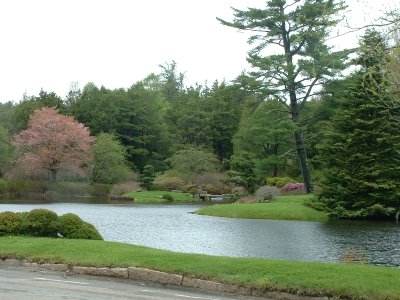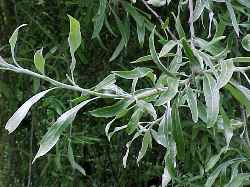Trees for Small Gardens
BY MICHAEL WEISHAN
Dwarf trees might be just what are needed to make the most of a compact yard all year-round When designing a small garden, my first concern is how to make the garden appear as large as possible. A number of visual tricks can achieve this goal. One of the most common is to run a distinct visual line, like a path or hedge, across the longest available axis and place a prominent object at its end. The viewer's eye is then drawn down the length of the landscape and concentrated at a distant focal point, making the garden appear larger than it really is. Different objects can serve as focal points: sculpture, architectural remnants, birdbaths, even outdoor furniture, such as benches. But my favorite in a small garden is a specially chosen dwarf tree.

Not only do small trees combine the decorative aspects of both art and architecture, but they also have one advantage no inanimate object can ever possess: an ever-changing beauty throughout the four seasons.
Choosing the appropriate tree, however, can prove tricky. The primary consideration is size -- if the tree outgrows its space, it can quickly convert itself from art form to artless mess. And since the tree will serve as both horticultural and structural landscape element, you'll need to select one that will thrive where you place it. Here are some excellent small trees I've had good experience with:

Acer griseum (cinnamon- or paperbark maple): This maple's remarkable cinnamon-colored bark peels off in brown, wavy strips. Often found as a multistemmed clump, it has small yellow flowers in the spring followed by wing-shaped maple seeds. In the fall, the olive-green summer foliage turns crimson -- setting the stage for the winter silhouette to come.


Pyrus salicifolia 'Pendula' (willow-leaved pear): Weeping trees in small landscapes often seem out of place. The silvery foliage of the 'Pendula', however, serves as counterpoint to other green plants in the garden. Though susceptible to fire blight, 'Pendula' is relatively trouble free.

Betula nigra 'Fox Valley' (dwarf river birch): Enjoy the columnar beauty of birch without the worry of the fatal birch borer pest -- 'Fox Valley' seems immune to it. Its bark peels off in gray-brown strips to reveal a lighter, pinkish-brown underbark. 'Fox Valley' prefers moist sites but will tolerate normal garden soil as long as it is not exposed to drought.

Juniperus scopulorum 'Skyrocket': Though the blue-gray evergreen foliage of this juniper remains the same year-round, the value of this plant is its narrow, pointed silhouette. Used alone, or in a group of three, the abrupt verticality of 'Skyrocket' junipers creates a dramatic profile.
Dwarf trees might be just what are needed to make the most of a compact yard all year-round When designing a small garden, my first concern is how to make the garden appear as large as possible. A number of visual tricks can achieve this goal. One of the most common is to run a distinct visual line, like a path or hedge, across the longest available axis and place a prominent object at its end. The viewer's eye is then drawn down the length of the landscape and concentrated at a distant focal point, making the garden appear larger than it really is. Different objects can serve as focal points: sculpture, architectural remnants, birdbaths, even outdoor furniture, such as benches. But my favorite in a small garden is a specially chosen dwarf tree.

Not only do small trees combine the decorative aspects of both art and architecture, but they also have one advantage no inanimate object can ever possess: an ever-changing beauty throughout the four seasons.
Choosing the appropriate tree, however, can prove tricky. The primary consideration is size -- if the tree outgrows its space, it can quickly convert itself from art form to artless mess. And since the tree will serve as both horticultural and structural landscape element, you'll need to select one that will thrive where you place it. Here are some excellent small trees I've had good experience with:

Acer griseum (cinnamon- or paperbark maple): This maple's remarkable cinnamon-colored bark peels off in brown, wavy strips. Often found as a multistemmed clump, it has small yellow flowers in the spring followed by wing-shaped maple seeds. In the fall, the olive-green summer foliage turns crimson -- setting the stage for the winter silhouette to come.


Pyrus salicifolia 'Pendula' (willow-leaved pear): Weeping trees in small landscapes often seem out of place. The silvery foliage of the 'Pendula', however, serves as counterpoint to other green plants in the garden. Though susceptible to fire blight, 'Pendula' is relatively trouble free.

Betula nigra 'Fox Valley' (dwarf river birch): Enjoy the columnar beauty of birch without the worry of the fatal birch borer pest -- 'Fox Valley' seems immune to it. Its bark peels off in gray-brown strips to reveal a lighter, pinkish-brown underbark. 'Fox Valley' prefers moist sites but will tolerate normal garden soil as long as it is not exposed to drought.

Juniperus scopulorum 'Skyrocket': Though the blue-gray evergreen foliage of this juniper remains the same year-round, the value of this plant is its narrow, pointed silhouette. Used alone, or in a group of three, the abrupt verticality of 'Skyrocket' junipers creates a dramatic profile.







0 Comments:
Post a Comment
<< Home